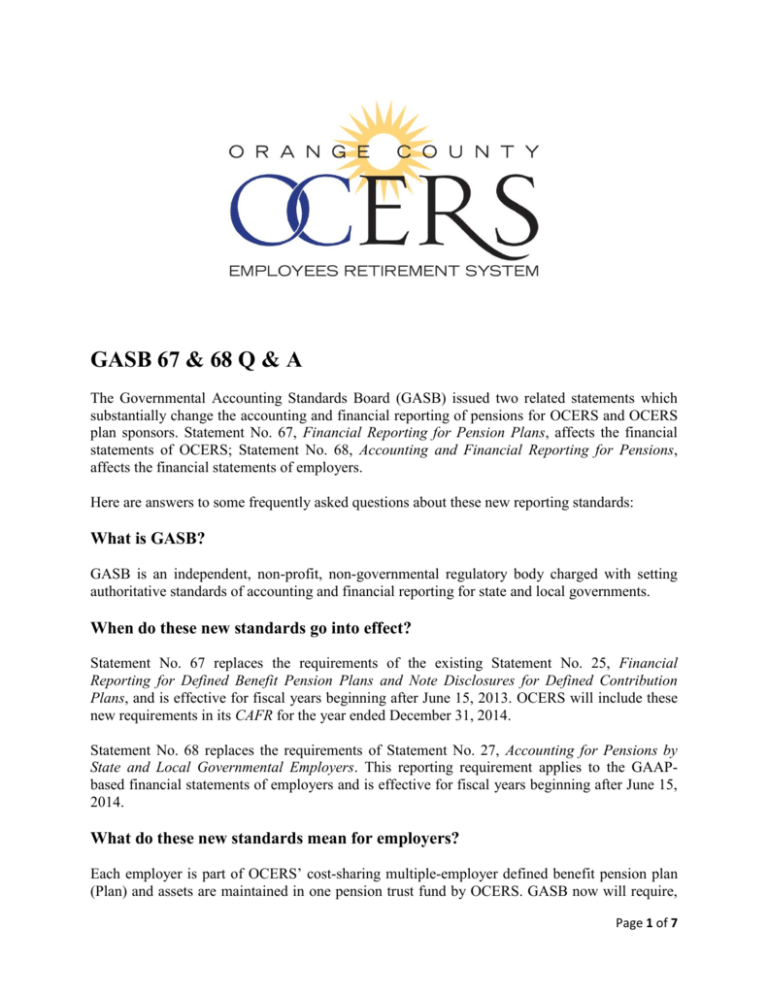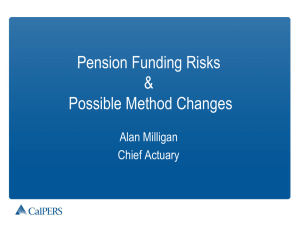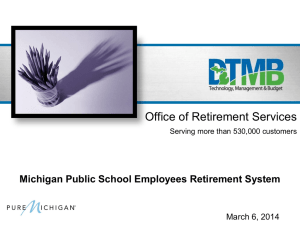GASB 67 & 68 Q & A
advertisement

GASB 67 & 68 Q & A The Governmental Accounting Standards Board (GASB) issued two related statements which substantially change the accounting and financial reporting of pensions for OCERS and OCERS plan sponsors. Statement No. 67, Financial Reporting for Pension Plans, affects the financial statements of OCERS; Statement No. 68, Accounting and Financial Reporting for Pensions, affects the financial statements of employers. Here are answers to some frequently asked questions about these new reporting standards: What is GASB? GASB is an independent, non-profit, non-governmental regulatory body charged with setting authoritative standards of accounting and financial reporting for state and local governments. When do these new standards go into effect? Statement No. 67 replaces the requirements of the existing Statement No. 25, Financial Reporting for Defined Benefit Pension Plans and Note Disclosures for Defined Contribution Plans, and is effective for fiscal years beginning after June 15, 2013. OCERS will include these new requirements in its CAFR for the year ended December 31, 2014. Statement No. 68 replaces the requirements of Statement No. 27, Accounting for Pensions by State and Local Governmental Employers. This reporting requirement applies to the GAAPbased financial statements of employers and is effective for fiscal years beginning after June 15, 2014. What do these new standards mean for employers? Each employer is part of OCERS’ cost-sharing multiple-employer defined benefit pension plan (Plan) and assets are maintained in one pension trust fund by OCERS. GASB now will require, Page 1 of 7 for purposes of governmental financial reporting, that a proportionate share of the total pension liability less the Plan’s fiduciary net position be shown on the face of each employer’s financial statements. Similarly, a proportionate share of the total pension expense and collective deferred inflows of resources and deferred outflows of resources of the pension trust fund at OCERS will also be shown on the face of each employer’s financial statements. In addition, these standards will require employers to include additional note disclosures about the pension trust fund in their financial statements. Is this liability due and payable immediately? No, the net pension liability is similar to other long-term liabilities reported on an employer’s balance sheet, in that it is not immediately due. Contribution rates are set by OCERS Board of Retirement annually. Will these changes affect the amount of contributions sent to OCERS? No, only the Board of Retirement has the authority to change the contribution rates. Although a proportionate share of the collective net pension liability is shown on the face of each employer’s financial statements, contribution requirements to OCERS are not directly impacted by this financial reporting change. Do the new GASB Statements establish requirements for how governments should fund their pensions? No, the new reporting standards break the link between actuarial funding and financial accounting for pensions. Previous GASB standards required pension plans to calculate the annual required contribution (ARC) and report payments toward the ARC. This measured the plan’s funding of the pension obligation. The new standards consider only how systems account for and report pension costs. Will OCERS provide net pension liability and other pension-related amounts to assist employers with GASB Statement No. 68? Yes, OCERS will provide several calculated items to assist employers. These items will be at both the pension trust fund, or collective level and the proportionate share, or employer level. The calculations to be provided include: net pension liability, deferred outflows of resources, deferred inflows of resources, and pension expense amounts. The information will be available approximately six months after the end of OCERS plan year. So for the first year of implementation, employers can expect to have the information in June 2015. Will the proportionate share calculation of the collective net pension liability and other collective pension-related amounts be audited? Yes, OCERS will prepare a schedule of employers’ allocation percentages for all employers participating in the Plan on an annual basis. It is understood at this time that this schedule will be Page 2 of 7 audited by OCERS’s auditors to ensure the employers are receiving accurate allocation information. The AICPA has published a white paper containing a proposed schedule of employer allocations. It’s important to note that OCERS can only provide the allocation percentage at the employer level within each rate group. An employer’s allocation percentage will be calculated for each OCERS reporting agency. However, if the OCERS reporting agency is a primary government with component units or is a component unit of a separate government, employers may need to perform further allocations or roll-ups of pension-related amounts based on their financial reporting structure. What is the basis used for calculating the employers’ allocation percentages? In accordance with the standard, OCERS will calculate the allocation percentage using the existing rate group structure. For rate groups with multiple employers, OCERS will use current year’s employer contributions on an accrual basis based on OCERS’s year-end of December 31. Employer contributions will include contributions made to OCERS to satisfy the employee contribution requirements that are not deposited in the member’s contribution account (per County Employees Retirement Law Section 31581.1). Employer contributions will NOT include contributions made by employees to satisfy employer contribution requirements (reverse pick-ups are excluded from the proportionate share calculation). OCERS will continue to share reports which employers can use to reconcile contributions made on a cash basis to the contribution amounts derived for the employer allocation percentage schedule. Will employers need to maintain amortization schedules for deferred outflows of resources and deferred inflows of resources? No. OCERS will maintain amortization schedules for pension-related information at the collective and employer level for the pension trust fund and the number of years each deferral is to be amortized. OCERS will also maintain the employer-level amortization schedules for deferrals arising from the change in the employer’s allocation percentage. However, it should be noted that the lowest level of information OCERS can provide employers is at the reporting agency level, which does not necessarily match the amounts an employer would need to report on their financial statements. Will OCERS assist employers with the note disclosures required by the new reporting standards? Yes. OCERS will provide sample note disclosures about the pension trust fund which employers can choose to include in their financial statements. It may be very difficult for employers to complete these pension trust fund disclosures without assistance from OCERS. However, the employer’s financial statements are the responsibility of the employer’s management, OCERS cannot and will not take responsibility or ownership for employer reporting requirements but instead will provide information for the disclosures that may be used. Page 3 of 7 When does OCERS publish its CAFR? OCERS’s fiscal year-end is December 31 and normally publishes its CAFR in late June following the fiscal year-end. It’s important to note that OCERS performs an actuarial valuation on an annual basis as of December 31. Historically, the valuation results for a given year were included in the current year’s CAFR, with the implementation of GASB 67, OCERS will be adopting the “rollforward” method of updating the previous year’s actuarial valuation for inclusion in the CAFR and in the schedules to be provided to employers. This is an allowable method by GASB and is necessary to reduce the risk of untimely information that could delay employer’s financial statements from being completed and audited. Where can I find additional information about the new pension reporting standards? The new reporting pronouncements are available on the GASB website. GASB also published a plain language document covering these pronouncements which may prove helpful. Consultation with an independent auditor or your own accountant about these GASB standards and their implementation also is encouraged. Will OCERS provide any information I can use to communicate these new reporting standards for pensions to my governing board? Yes. OCERS has developed a fact sheet for the specific purpose to help communicate the issues surrounding the new reporting standards to your governing boards. Are the new reporting standards, detailed in Statement Nos. 67 and 68, applicable to Other Postemployment Benefit (OPEB) plans? No. GASB Statement Nos. 67 and 68 do not apply to OPEB plans. Currently, GASB is deliberating the possibility of adopting improvements to the existing standards for accounting and financial reporting for OPEB plans. New guidance pertaining to OPEB plans currently is in Exposure Draft form with final guidance anticipated in June 2015. Who do I contact with specific questions about the new reporting standards? Please contact Brenda Shott, Assistant CEO, Finance and Internal Operations at bshott@ocers.org or Tracy Bowman, Director of Finance at tbowman@ocers.org for any questions you have regarding the new reporting standards. Page 4 of 7 Useful Links Official GASB Links Governmental Accounting Standards Board (GASB) GASB Toolkit—GASB’s pension implementation toolkit assists governments in implementation on Statement No. 68 and Statement No. 71. GASB Statement No. 67—Financial Reporting for Pension Plans GASB Statement No. 68—Accounting and Financial Reporting for Pensions—an amendment of GASB Statement No. 27 GASB Statement No. 68 Implementation Guide—Guide to implementation of GASB Statement No. 68 on Accounting and Financial Reporting for Pensions GASB Statement No. 71—Pension Transition for Contributions Made Subsequent to the Measurement Date—an amendment of GASB Statement No. 68 GASB declines to delay implementation date of pension standards March 24, 2014 Planning For New Pension Statements Auditing AICPA Whitepaper: Single-Employer and Cost-Sharing Multiple-Employer Plans: Issues Associated with Testing Census Data in an Audit of Financial Statements—The purpose of this whitepaper is to address the role of census data in single-employer and costsharing plan financial statements and the plan auditor’s responsibility for such census data. Single-employer and cost-sharing plans are covered together in this whitepaper because they have similar reporting and disclosure requirements. This whitepaper addresses the responsibility of the cost-sharing plan to obtain all necessary information and the plan auditors to obtain sufficient appropriate evidence regarding the completeness and accuracy of all census data underlying certain financial statement elements of the plan. AICPA Whitepaper: Governmental Employer Participation in Cost-Sharing MultipleEmployer Plans: Issues Related to Information for Employer Reporting—This whitepaper was prepared by the AICPA State and Local Government Expert Panel (SLGEP) and is intended to describe accounting and auditing issues facing governmental employers (employers) that participate in cost-sharing multiple-employer defined benefit pension plans (cost-sharing plan or plan), as well as best practice solutions to address these issues. KPMG Webcast: Critical Issues in Implementing the New GASB Pension Standards — A Look at Where We Are Now—The KPMG Government Institute, and partners and professionals of KPMG LLP, invite you to join them for an urgent discussion of critical issues facing governments as they implement the new Governmental Accounting Standards Board (GASB) pension standards. The discussion will include the status of the AICPA's proposed recommendations for plans to communicate pension information to employer governments, as well as AICPA pension-related audit guidance. Page 5 of 7 Other Resources GRS Insight: The GASB’s New Pension Accounting and Financial Reporting Standards Page 6 of 7 Glossary Net Pension Liability (NPL)—Each employer’s share of the unfunded liability (Total Pension Liability minus the Pension Plan’s Fiduciary Net Position) associated with their employees who participate in OCERS. Discount Rate—A blended or single rate (expressed as a percentage) that reflects (1) the longterm expected rate of return on pension plan investments to the extent (a) this rate will support projected benefit payments of the plan, and, (b) assets will be invested using the current allocation targeted to achieve that return, and (2) for the period of benefit payments not supported, will incorporate an index rate for 20-year tax-exempt municipal bonds. Employer’s Proportion—A measure of the proportionate relationship of an employer of a costsharing pension plan like OCERS to all employers of the plan. Pension Expense—Represented by changes in OCERS’s Net Pension Liability, recognized in the current reporting period. There are some exceptions that include changes due to differences between expected and actual experience, changes in economic and demographic assumptions, and the difference between projected and actual earnings on pension plan investments. Pension Plan’s Fiduciary Net Position—Difference between assets, plus deferred outflows of resources, minus liabilities, minus deferred inflows of resources of the plan. Proportionate Shares—Measures of the collective Net Pension Liability, collective Pension Expense and other disclosure items of the plan related to pensions—attributable to a specific employer, based on the Employer’s Proportion. Total Pension Liability—The portion of the actuarial present value of projected benefit payments (reflecting projected service and anticipated salary and benefit increases) that is attributed to past periods of OCERS member service, similar to current Actuarial Accrued Liability (AAL), determined under the Entry Age Actuarial Cost Method, calculated using the Discount Rate. Page 7 of 7







